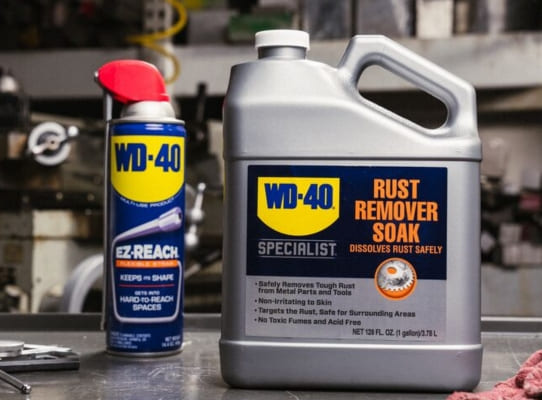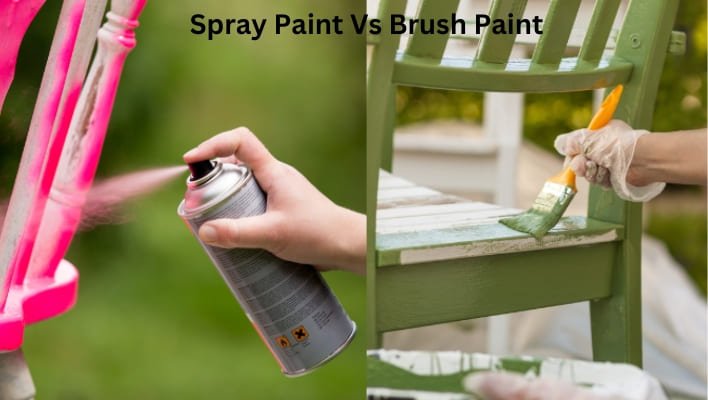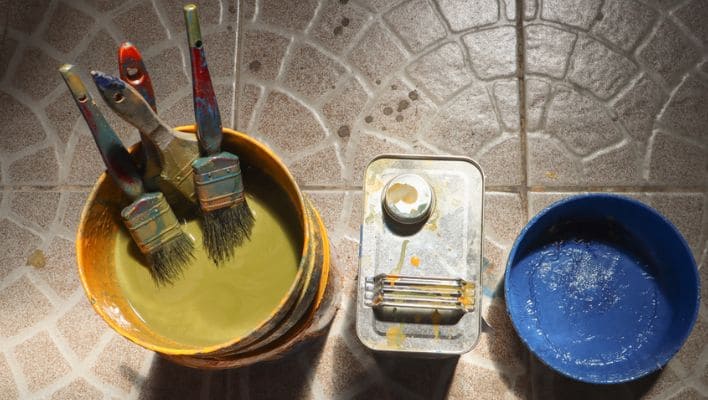Ever had a moment where you stared at something plastic covered in paint, wondering how to fix it? Well, that’s where WD-40 steps in – your handy helper for household problems. It’s not just for getting rid of grease and grime; think of it as a magic solution that effortlessly removes both wet and dry paint stains from plastic without any hassle. WD-40, versatile at home, excels in lubrication and penetration for reliable use in various tasks.
Whether you’re dealing with unexpected paint splashes on your car, metal surfaces, or trying to rescue plastic items from graffiti, WD-40 comes to the rescue. With WD-40, you’re not just purchasing a product; you’re gaining an easy and trustworthy way to make your favorite things look good again. In this article, we’ll delve into the effects of WD-40 on painted plastic, exploring potential outcomes and providing recommendations for safe usage.
Table of Contents
- WD-40 Paint remover:
- Effects on Painted Plastic:
- Safety Guidelines before using WD-40
- How to remove paint from plastic without damaging?
- Testing WD-40:
- Applying WD-40 To remove dried paint:
- Gentle Scrape
- Repeat as Needed:
- Cleaning the Surface:
- Handling Dried Spray Paint on Solid Surfaces:
- Concrete or Rough Exteriors:
- Clothes or Fabric:
- Conclusion On Will Wd-40 Remove Paint From Plastic:
- FAQS
- how to remove paint from textured plastic?
- Is WD-40 a good paint remover?
- Does WD-40 remove paint from glass?
- Does WD-40 restore plastic?
- Rosalie Sanchez
WD-40 Paint remover:
WD-40’s versatile formula, known as Water Displacement, 40th formula. It is a multi-purpose spray, primarily designed to displace moisture, remove paint, lubricate moving parts, and provide a protective coating against rust and corrosion. It’s not just limited to removing paint from plastic. You can confidently apply it to remove painted metal surfaces, rubber, laminating floors, glass, wood, without fearing damage to the paint.
It works effectively by loosening and thinning the paint, making the removal process smooth and hassle-free. Its composition includes mineral oil, a petroleum-based solvent, and various other ingredients, making it effective for a wide range of applications.
Effects on Painted Plastic:

When it comes to painted plastic, WD-40 can be quite effective at removing certain paint types. Its solvent properties work by softening and breaking down the paint, facilitating easier wiping or scraping. However, the success of this process depends on factors like the paint type, the plastic material, and how long WD-40 is in contact with the surface.
Surprisingly, WD-40 is quite strong and works well for removing paint. It’s like a tough liquid made from petroleum, similar to mineral spirits. It works best on paints that use water and latex but isn’t as powerful on oil-based paints.
If you’re considering WD-40 to remove paint, do it when the paint is still wet or freshly dried. It’s not ideal for large areas but works well for small spots. Spray a bit to test its effectiveness and avoid accidentally damaging your plastic item.
Safety Guidelines before using WD-40
Safety comes first when using WD-40. Begin by working in a well-ventilated space to avoid breathing in any fumes. Cover nearby surfaces that you don’t want affected by WD-40 to prevent accidental damage. It’s important to limit the time WD-40 stays on the painted plastic to minimize the risk of damage.
Remember that high concentrations of WD-40 may lead to nasal and respiratory irritation, along with potential central nervous system effects like headaches, dizziness, and nausea. Always follow safety data sheet wd-40 guidelines, and in case of skin contact, be aware of potential irritation such as redness, itching, and burning. So, consider wearing a mask, especially when working indoors, for added safety.
How to remove paint from plastic without damaging?
Here are the steps for Using WD-40 on painted plastic:
Testing WD-40:
Start by testing WD-40 on a small area of the painted plastic. This initial test allows you to observe how the plastic and paint react to WD-40.
Applying WD-40 To remove dried paint:
Spray a little WD-40 directly on the painted surface. Allow WD-40 a few minutes to penetrate the paint effectively.
Gentle Scrape
After applying WD-40, take a soft cloth, sponge, or a plastic scraper to gently get rid of the dried paint that has softened. Make sure, not to deeply scratch or damage the plastic surface during this step.
Repeat as Needed:
Depending on how thick the paint is, you may need to repeat the process until you achieve the desired result. Stubborn or multiple layers of paint may require a few extra applications.
Cleaning the Surface:
After successfully removing the paint, clean the plastic surface with a mix of mild soap and water. This step is important to get rid of any WD-40 residue, leaving the surface clean and polished.
Handling Dried Spray Paint on Solid Surfaces:
For dried spray paint on solid surfaces like metal, plastic, or glass, spritz WD-40 onto the stain, wait a minute, and then scrub with a cloth. WD-40’s degreasing power lifts the pigment without harming the surface.
Concrete or Rough Exteriors:
If dealing with rough exteriors like concrete, use a hard-bristle brush instead of a paper towel. Let the WD-40 sit for 5 to 10 minutes before scrubbing to effectively remove dried paint.
Clothes or Fabric:
To tackle dried paint on clothes or fabric, apply WD-40 to the entire stain, blot with a sponge, and use a cloth to wipe the area. If you’re working on thicker fibers like carpet, let the WD-40 soak in for 20 to 30 minutes before you start scrubbing. This helps to effectively tackle the dried paint without harming the carpet fibers. Repeat the process if needed. Once the paint is gone, clean the fabric with dish soap and rinse with warm water.
Conclusion On Will Wd-40 Remove Paint From Plastic:
Certainly, WD-40 proves effective in removing paint from plastic surfaces due to its solvent properties. The outcome relies on variables like the paint type and contact duration. By taking necessary precautions, such as ensuring proper ventilation and protecting adjacent surfaces, WD-40 emerges as a versatile solution for spot removal. Its capacity to restore painted plastic surfaces showcases its efficiency with simplicity and ease.
FAQS
how to remove paint from textured plastic?
Create a paste with baking soda and water, brush it on the plastic, focusing on painted areas and grooves. For stubborn stains, allow it to sit, then rinse with soapy water and dry by hand.
Is WD-40 a good paint remover?
Yes, WD-40 is a reliable paint remover for cars. It works well on both fresh and dried paint stains without harming the surface. This product effectively softens the paint, and for stubborn cases, applying Vaseline overnight can enhance its efficiency. WD-40 provides a straightforward solution to paint removal, ensuring ease of use and preserving your car’s appearance.
Does WD-40 remove paint from glass?
Yes, WD-40 is effective in removing paint from glass surfaces. This product is not only suitable for lifting paint stains from various surfaces but also proves efficient on glass and laminate flooring. The lubricant in WD-40 breaks down paint molecules, making it easier to lift stubborn marks cleanly. Its versatile nature makes it a handy solution for tackling paint stains on different surfaces, ensuring a clean and efficient removal process, especially on glass.
Does WD-40 restore plastic?
To make plastic look new again, use WD-40 Specialist Silicone. Just spray a bit on a cloth, rub it on the plastic, and see the shine come back. It’s an easy way to refresh the appearance of your plastic items and make them look like they did when they were new.

Rosalie Sanchez
DIY enthusiast with years of experience in home decor and home improvement. With a passion for educating consumers about DIY projects. Every time, I work with our painting professionals to provide you with the best painting product reviews and how-to advice. You can follow me on Facebook.


